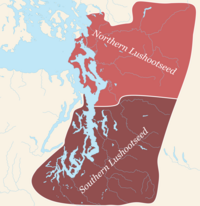The Skagit (/ˈskædʒɪt/ SKAJ-it; Lushootseed: sqaǰətabš, Lushootseed pronunciation: [sqɑd͡ʒətɑbʃ]; "People Who Hide" or "People Who Run and Hide Upriver [the Skagit River]") refers to either of two modern-day tribes of Lushootseed-speaking Native American people living in the state of Washington: the Upper Skagit tribe, and the Lower Skagit band of the Swinomish tribe.
The Upper Skagit and Lower Skagit both speak subdialects of Northern Lushootseed. The Upper Skagit speak Skagit. As of 1977[update], there were an estimated 100 speakers of Skagit.[1] The Lower Skagit speak Swinomish, the subdialect of the Swinomish people.
Traditionally, Skagit referred only to the Lower Skagit on Whidbey Island. However, after colonization, the word Skagit was used to refer to both groups.
The Skagit River, Skagit Bay, and Skagit County all derive their names from the Skagit peoples.
References
[edit]- ^ Skagit at Ethnologue (18th ed., 2015) (subscription required)

Well, that’s interesting to know that Psilotum nudum are known as whisk ferns. Psilotum nudum is the commoner species of the two. While the P. flaccidum is a rare species and is found in the tropical islands. Both the species are usually epiphytic in habit and grow upon tree ferns. These species may also be terrestrial and grow in humus or in the crevices of the rocks.
View the detailed Guide of Psilotum nudum: Detailed Study Of Psilotum Nudum (Whisk Fern), Classification, Anatomy, Reproduction